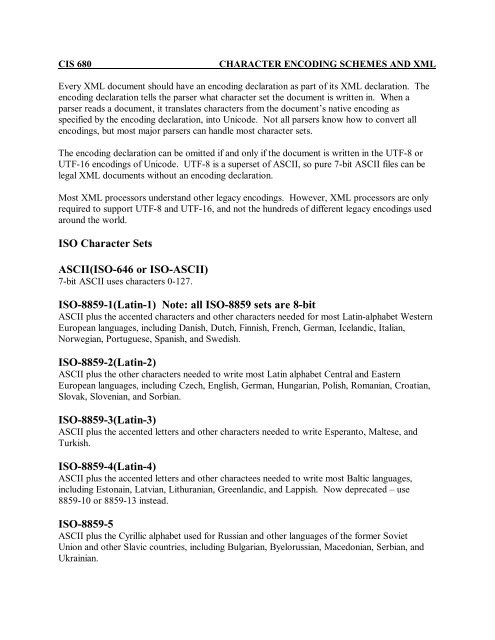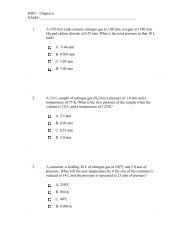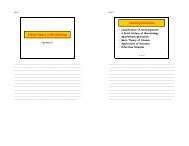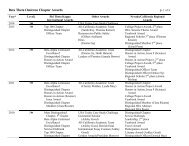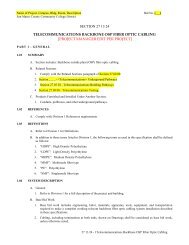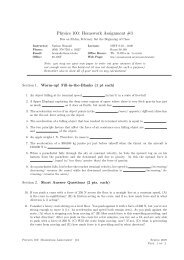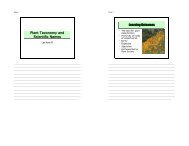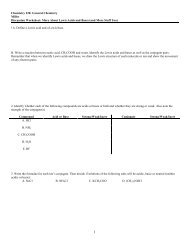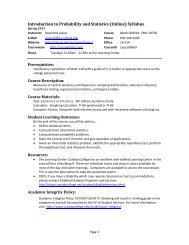ISO Character Sets ASCII(ISO-646 or ISO-ASCII)
ISO Character Sets ASCII(ISO-646 or ISO-ASCII)
ISO Character Sets ASCII(ISO-646 or ISO-ASCII)
You also want an ePaper? Increase the reach of your titles
YUMPU automatically turns print PDFs into web optimized ePapers that Google loves.
CIS 680<br />
CHARACTER ENCODING SCHEMES AND XML<br />
Every XML document should have an encoding declaration as part of its XML declaration. The<br />
encoding declaration tells the parser what character set the document is written in. When a<br />
parser reads a document, it translates characters from the document’s native encoding as<br />
specified by the encoding declaration, into Unicode. Not all parsers know how to convert all<br />
encodings, but most maj<strong>or</strong> parsers can handle most character sets.<br />
The encoding declaration can be omitted if and only if the document is written in the UTF-8 <strong>or</strong><br />
UTF-16 encodings of Unicode. UTF-8 is a superset of <strong>ASCII</strong>, so pure 7-bit <strong>ASCII</strong> files can be<br />
legal XML documents without an encoding declaration.<br />
Most XML process<strong>or</strong>s understand other legacy encodings. However, XML process<strong>or</strong>s are only<br />
required to supp<strong>or</strong>t UTF-8 and UTF-16, and not the hundreds of different legacy encodings used<br />
around the w<strong>or</strong>ld.<br />
<strong>ISO</strong> <strong>Character</strong> <strong>Sets</strong><br />
<strong>ASCII</strong>(<strong>ISO</strong>-<strong>646</strong> <strong>or</strong> <strong>ISO</strong>-<strong>ASCII</strong>)<br />
7-bit <strong>ASCII</strong> uses characters 0-127.<br />
<strong>ISO</strong>-8859-1(Latin-1) Note: all <strong>ISO</strong>-8859 sets are 8-bit<br />
<strong>ASCII</strong> plus the accented characters and other characters needed f<strong>or</strong> most Latin-alphabet Western<br />
European languages, including Danish, Dutch, Finnish, French, German, Icelandic, Italian,<br />
N<strong>or</strong>wegian, P<strong>or</strong>tuguese, Spanish, and Swedish.<br />
<strong>ISO</strong>-8859-2(Latin-2)<br />
<strong>ASCII</strong> plus the other characters needed to write most Latin alphabet Central and Eastern<br />
European languages, including Czech, English, German, Hungarian, Polish, Romanian, Croatian,<br />
Slovak, Slovenian, and S<strong>or</strong>bian.<br />
<strong>ISO</strong>-8859-3(Latin-3)<br />
<strong>ASCII</strong> plus the accented letters and other characters needed to write Esperanto, Maltese, and<br />
Turkish.<br />
<strong>ISO</strong>-8859-4(Latin-4)<br />
<strong>ASCII</strong> plus the accented letters and other charactees needed to write most Baltic languages,<br />
including Estonain, Latvian, Lithuranian, Greenlandic, and Lappish. Now deprecated – use<br />
8859-10 <strong>or</strong> 8859-13 instead.<br />
<strong>ISO</strong>-8859-5<br />
<strong>ASCII</strong> plus the Cyrillic alphabet used f<strong>or</strong> Russian and other languages of the f<strong>or</strong>mer Soviet<br />
Union and other Slavic countries, including Bulgarian, Byel<strong>or</strong>ussian, Macedonian, Serbian, and<br />
Ukrainian.
<strong>ISO</strong>-8859-6<br />
<strong>ASCII</strong> plus Arabic, not including Farsi and Urdu.<br />
<strong>ISO</strong>-8859-7<br />
<strong>ASCII</strong> plus modern Greek. This set does not have the extra letters and accents necessary f<strong>or</strong><br />
ancient and Byzantine Greek.<br />
<strong>ISO</strong>-8859-8<br />
<strong>ASCII</strong> plus Hebrew script used f<strong>or</strong> Hebrew and Yiddish.<br />
<strong>ISO</strong>-8859-9(Latin-5)<br />
Like Latin-1, except six letters used in Icelandic have been replaced with six letters used in<br />
Turkish.<br />
<strong>ISO</strong>-8859-10(Latin-6)<br />
<strong>ASCII</strong> plus accented letters and other characters needed to write most Baltic languages,<br />
including Estonian, Icelandic, Latvian, Lithuanian, Greenlandic, and Lappish.<br />
<strong>ISO</strong>-8859-11<br />
<strong>ASCII</strong> plus Thai.<br />
<strong>ISO</strong>-8859-13(Latin-7)<br />
Similar to Latin-6, except with some question marks.<br />
<strong>ISO</strong>-8859-14(Latin-8)<br />
<strong>ASCII</strong> plus Celtic languages, including Gaelic and Welsh.<br />
<strong>ISO</strong>-8859-15(Latin-9, Latin-0)<br />
A revived version of Latin-1 that replaces symbols such as<br />
letters. Includes the Euro currency symbol .<br />
¢¡¤£¦¥ § ¨© § © ¤ ¨ ¤¥ ¥ ¨<br />
Unicode<br />
Unicode is an international standard character set that can be used to write documents in most<br />
languages. The latest version, 3.0.1, contains 49,194 characters. Unicode covers the Latin<br />
alphabet, Greek-derived scripts(including ancient and modern), Cyrillic scripts. Unicode also<br />
covers ideographic scripts, including the Han character set used f<strong>or</strong> Chinese and Japanese, the<br />
K<strong>or</strong>ean Hangul syllabury, and phonetic representations of these languages, including Katakana<br />
and Hiragana. It covers right-to-left Arabic and Hebrew scripts. It covers scripts of the Indian<br />
subcontinent, including Devanagari, Thai, Bengali, and Tibetan. Unicode can potentially hold<br />
m<strong>or</strong>e than a million characters.<br />
UCS-2 and UTF-16<br />
UCS-2(Universal <strong>Character</strong> System-2), also known as <strong>ISO</strong>-10<strong>646</strong>-UCS-2, represents each<br />
character as a two-byte, unsigned integer between 0 and 65,535. A document that uses UCS-2
plus “surrogate pairs” is in UTF-16 encoding. UTF stands f<strong>or</strong> Unicode Transf<strong>or</strong>mation<br />
F<strong>or</strong>mat.<br />
UTF-8<br />
UTF-8 is a variable-length encoding of Unicode. <strong>Character</strong>s 0 through 127(the <strong>ASCII</strong> character<br />
set) are encoded in 1 byte each. Pure <strong>ASCII</strong> files are also acceptable UTF-8 files. UTF-8<br />
represents characters 128 to 2047 in 2 bytes each. The remaining characters, mostly from<br />
Chinese, Japanese, and K<strong>or</strong>ean, are represented in three bytes each. When characters with code<br />
points(numeric values) above 65, 535 are added to Unicode, they will be encoded in four bytes.<br />
UTF-8 is the most broadly supp<strong>or</strong>ted encoding of Unicode. It is how Java .class files st<strong>or</strong>e<br />
strings, and it is the default encoding an XML process<strong>or</strong> uses.<br />
Unicode code charts are at:<br />
www.unicode.<strong>or</strong>g/charts
<strong>ISO</strong> 639:1988<br />
"Code f<strong>or</strong> the<br />
representation of<br />
names of languages".<br />
aa Afar<br />
ab Abkhazian<br />
af Afrikaans<br />
am Amharic<br />
ar Arabic<br />
as Assamese<br />
ay Aymara<br />
az Azerbaijani<br />
ba Bashkir<br />
be Byel<strong>or</strong>ussian<br />
bg Bulgarian<br />
bh Bihari<br />
bi Bislama<br />
bn Bengali; Bangla<br />
bo Tibetan<br />
br Breton<br />
ca Catalan<br />
co C<strong>or</strong>sican<br />
cs Czech<br />
cy Welsh<br />
da Danish<br />
de German<br />
dz Bhutani<br />
el Greek<br />
en English<br />
eo Esperanto<br />
es Spanish<br />
et Estonian<br />
eu Basque<br />
fa Persian<br />
fi Finnish<br />
fj Fiji<br />
fo Faeroese<br />
fr French<br />
fy Frisian<br />
ga Irish<br />
gd Scots Gaelic<br />
gl Galician<br />
gn Guarani<br />
gu Gujarati<br />
ha Hausa<br />
hi Hindi<br />
hr Croatian<br />
hu Hungarian<br />
hy Armenian<br />
ia Interlingua<br />
ie Interlingue<br />
ik Inupiak<br />
in Indonesian<br />
is Icelandic<br />
it Italian<br />
iw Hebrew<br />
ja Japanese<br />
ji Yiddish<br />
jw Javanese<br />
ka Ge<strong>or</strong>gian<br />
kk Kazakh<br />
kl Greenlandic<br />
km Cambodian<br />
kn Kannada<br />
ko K<strong>or</strong>ean<br />
ks Kashmiri<br />
ku Kurdish<br />
ky Kirghiz<br />
la Latin<br />
ln Lingala<br />
lo Laothian<br />
lt Lithuanian<br />
lv Latvian, Lettish<br />
mg Malagasy<br />
mi Ma<strong>or</strong>i<br />
mk Macedonian<br />
ml Malayalam<br />
mn Mongolian<br />
mo Moldavian<br />
mr Marathi<br />
ms Malay<br />
mt Maltese<br />
my Burmese<br />
na Nauru<br />
ne Nepali<br />
nl Dutch<br />
no N<strong>or</strong>wegian<br />
oc Occitan<br />
om (Afan) Oromo<br />
<strong>or</strong> Oriya<br />
pa Punjabi<br />
pl Polish<br />
ps Pashto, Pushto<br />
pt P<strong>or</strong>tuguese<br />
qu Quechua<br />
rm Rhaeto-Romance<br />
rn Kirundi<br />
ro Romanian<br />
ru Russian<br />
rw Kinyarwanda<br />
sa Sanskrit<br />
sd Sindhi<br />
sg Sangro<br />
sh Serbo-Croatian<br />
si Singhalese<br />
sk Slovak<br />
sl Slovenian<br />
sm Samoan<br />
sn Shona<br />
so Somali<br />
sq Albanian<br />
sr Serbian<br />
ss Siswati<br />
st Sesotho<br />
su Sundanese<br />
sv Swedish<br />
sw Swahili<br />
ta Tamil<br />
te Tegulu<br />
tg Tajik<br />
th Thai<br />
ti Tigrinya<br />
tk Turkmen<br />
tl Tagalog<br />
tn <strong>Sets</strong>wana<br />
to Tonga<br />
tr Turkish<br />
ts Tsonga<br />
tt Tatar<br />
tw Twi<br />
uk Ukrainian<br />
ur Urdu<br />
uz Uzbek<br />
vi Vietnamese<br />
vo Volapuk<br />
wo Wolof<br />
xh Xhosa<br />
yo Y<strong>or</strong>uba<br />
zh Chinese<br />
zu Zulu


